
Beetles are insects that form the order Coleoptera, in the superorder Holometabola. Their front pair of wings are hardened into wing-cases, elytra, distinguishing them from most other insects. The Coleoptera, with about 400,000 described species, is the largest of all orders, constituting almost 40% of described insects and 25% of all known animal species; new species are discovered frequently, with estimates suggesting that there are between 0.9 and 2.1 million total species. However, the number of beetle species is challenged by the number of species in dipterans (flies) and hymenopterans (wasps).
Stridulation is the act of producing sound by rubbing together certain body parts. This behavior is mostly associated with insects, but other animals are known to do this as well, such as a number of species of fish, snakes and spiders. The mechanism is typically that of one structure with a well-defined lip, ridge, or nodules being moved across a finely-ridged surface or vice versa, and vibrating as it does so, like the dragging of a phonograph needle across a vinyl record. Sometimes it is the structure bearing the file which resonates to produce the sound, but in other cases it is the structure bearing the scraper, with both variants possible in related groups. Common onomatopoeic words for the sounds produced by stridulation include chirp and chirrup.

The Asian long-horned beetle, also known as the starry sky, sky beetle, or ALB, is native to the Korean Peninsula, northern and southern China, and disputably in northern Japan. This species has now been accidentally introduced into the eastern United States, where it was first discovered in 1996, as well as Canada, and several countries in Europe, including Austria, France, Germany, Italy and UK.

The longhorn beetles (Cerambycidae), also known as long-horned or longicorns, are a large family of beetles, with over 35,000 species described.

The Chrysomeloidea are an enormous superfamily of beetles, with tens of thousands of species. The largest families are Cerambycidae, long-horned beetles, with more than 35,000 species, and Chrysomelidae, leaf beetles, with more than 13,000 species.

The musk beetle is a Eurasian species of longhorn beetle belonging to the subfamily Cerambycinae, tribe Callichromatini. Its name comes from the delicate musky smell it emits when menaced. The beetle has a shell with an iridescence tone that changes with the angle of view. It has a hard shell around the thorax with hard sharp spines.
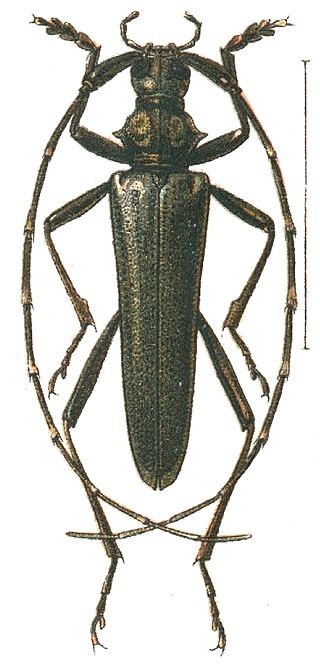
The Disteniidae are a small family of beetles in the superfamily Chrysomeloidea, traditionally treated as a group within the Cerambycidae.

Clytus arietis, the wasp beetle, is a wasp-mimicking longhorn beetle species in the genus Clytus.

Lepturinae, the lepturine beetles, is a subfamily of the longhorn beetle family (Cerambycidae), containing about 150 genera worldwide. This lineage is most diverse in the Northern Hemisphere. Until recently the subfamily Necydalinae was included within the lepturines, but this has been recently recognized as a separate subfamily. Nine tribes are usually recognized today, with a tenth, Caraphiini, created in 2016. A few genera are of uncertain placement within the subfamily.
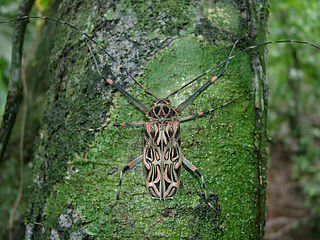
The harlequin beetle is a large and distinctly colored species of longhorn beetle from the Neotropics and the only member of the genus Acrocinus.
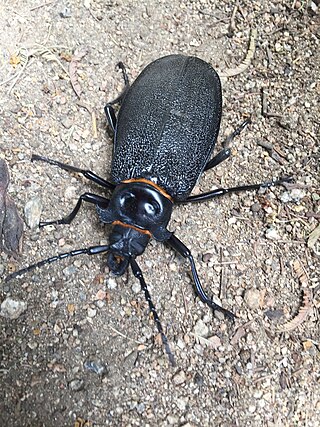
Acanthinodera is a genus of longhorned beetles in the family Cerambycidae. It is monotypic, being represented by the single species Acanthinodera cumingii. It is the largest species of beetle in Chile. The beetle is endemic to central Chile and can be found from IV Coquimbo Region to IX La Araucanía Region.

Plocaederus is a genus of Long-Horned Beetles in the beetle family Cerambycidae. This genus has a single species, Plocaederus bellator. It is known from the South American countries Brazil, Ecuador, Guyana, French Guiana, Paraguay, and Suriname.

Trachyderini is a tribe of long-horned beetles in the family Cerambycidae. There are at least 140 genera and 650 described species in Trachyderini.
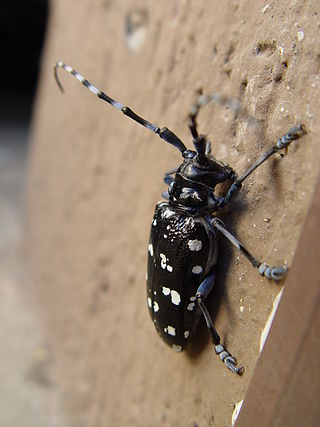
Anoplophora is a genus of beetles in the longhorn beetle family (Cerambycidae). They are native to Asia. Most are large and colorful and thus are depicted in artwork and sought after by beetle collectors. The genus also includes several notorious pest insects.

Onychocerus albitarsis is a relatively rare species of beetle in the family Cerambycidae from the Amazon and Atlantic forest regions in Brazil, Bolivia, Paraguay and southern Peru. It is remarkable for being the only known beetle that has a venomous sting and the only known arthropod that stings with its antennae. Each antenna ends in a stinger that has evolved to resemble a scorpion's tail and it is connected to a venom gland. The sting was already reported in 1884 but researchers thought the pain only was caused by the sharpness of the antennae, as also known from some other beetles. It was only confirmed in 2005 that it is venomous when a biologist was stung, comparing it to a bee sting, and subsequently studied it in detail. In the first of two other cases where the identity of the stinging insect was confirmed to be this beetle, a woman experienced significant pain directly after the incident, and redness and itching at the sting site that lasted for a week. In the other case a man experienced moderate pain directly after being stung and redness that only lasted for an hour. The other species in the genus Onychocerus appear to not be venomous since they lack the structures inside the antennae that are associated with the venom apparatus of Onychocerus albitarsis.
Dmytro Zajciw was a Ukrainian and Brazilian entomologist, notable for his many beetle discoveries and for his collection. He was born in Velyka Mykhailivka, Ukraine and died in Rio de Janeiro, Brazil. He was the author of Two new genera and species of neotropical Longhorn beetles , 1957, Contribution to the study of Longhorn beetles of Rio de Janeiro , 1958, and was the first to describe the genera Adesmoides and Pseudogrammopsis, as well as the species Beraba angusticollis and Mionochroma subaurosum, among many others.
Estola brunnescens is a species of beetle in the family Cerambycidae. It was described by Stephan von Breuning in 1940. It is known from Colombia and Venezuela.
Estola freyi is a species of beetle in the family Cerambycidae. It was described by Stephan von Breuning in 1955. It is known from Trinidad.
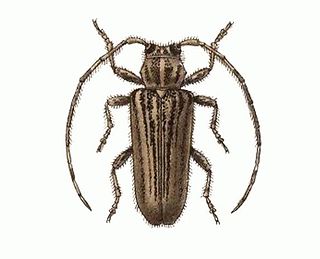
Estola vittulata is a species of beetle in the family Cerambycidae. It was described by Henry Walter Bates in 1874. It is known from Panama, Mexico and Venezuela.

Iberodorcadion fuliginator is a species of beetle in the family Cerambycidae. It was described by Carl Linnaeus in his landmark 1758 10th edition of Systema Naturae. It is known from Central Europe: Spain, Belgium, Luxembourg, Netherlands, Portugal, France, Germany, Austria, Lithuania, and Switzerland.















